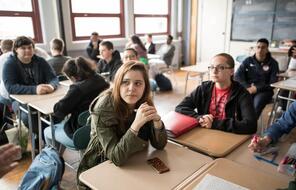"More in Common Than We Thought" – Chicago, Parkland Youth Stand in Solidarity
At a Glance
Language
English — USSubject
- Civics & Citizenship
- History
- Social Studies
- Democracy & Civic Engagement
The following article from the Chicago Sun-Times describes a meeting between Parkland and Chicago students during their Road to Change tour.
Parkland shooting survivor Cameron Kasky didn’t travel to Chicago to speak for his friends from violence-plagued areas of the South or West Sides.
Au contraire. As one of the more out front students who launched the #NeverAgain movement in wake of the shooting that left 17 dead at his Florida school, Kasky won’t even talk to you unless you’re talking to teens from areas like North Lawndale, Woodlawn or Auburn-Gresham, too.
“The Parkland tragedy got the attention it did because Parkland is an affluent, white community, and so many people in this country will only watch the news when that happens to an affluent, white community,” Kasky, 17, said in an interview with the Chicago Sun-Times.
“When it happens to the majority of communities in this country, those people don’t care. They shrug it off.”
He and other Parkland students hit Chicago this weekend to kickoff their 20-city Road to Change tour that will register youth voters in an effort to combat gun violence through legislative changes.
Kasky and Parkland student Alfonso Calderon, 16, stopped by the Sun-Times newsroom with Chicago peers Trinity Cole-Reid of Auburn-Gresham; Arieyanna Williams of North Lawndale; and Rie’Onna Holmon of Woodlawn.
“Obviously, what happened to us was horrific. I don’t think anybody’s going to argue that. But in my opinion, I think what our friends go through here every day is worse. So far this year, 147 kids have been killed in Chicago,” Calderon noted.
These eloquent youth were quick to address a burning question: Why is it that youth in black and brown, poverty-stricken communities like those in Chicago where guns daily wreak havoc can’t draw similar national outrage?
The Parkland students’ movement spawned the historic March For Our Lives events that drew hundreds of thousands to rallies in Washington, D.C., and across the nation, including one held here in Union Park. It also spawned new gun sale policies at major retail giants; high-profile companies ending corporate partnerships with the National Rifle Association; and Florida’s first gun control legislation in 22 years.
“I think we got so much attention not just because we are obviously white and because we live in such a rich community, but because we are literally 45 minutes from the president’s home in Mar-a-Lago,” Calderon said. “The reason people cared so much is because it is the same group of people who are leading the country and who are in control right now of our laws.”
Later Friday, the teens joined Parkland student Emma Gonzalez, celebrities Jennifer Hudson and Chance The Rapper, and former U.S. Rep. Gabby Giffords (D-Az.), who was shot in the head in a 2011 shooting, at St. Sabina Church’s annual end-of-school-year rally and peace march.
It wasn’t lost on the Chicago teens that they’d likely not draw the support of such luminaries and attendant media coverage on their own. “It’s sad to say that we wouldn’t be where we are today if it wasn’t for the Parkland students,” said Holmon, 15, who for two years has raised her voice against Chicago violence as a member of the youth group B.R.A.V.E.
“What we go through in Chicago happens day to day, at any hour, minute, second of the day, and it barely makes the news,” Holmon said. “People listen to them. They see their anger as being passionate, while they see us as just angry teenagers. I’m grateful for the platform they gave us, but it would have been great if our voices could have been heard without them.”
Cole-Reid agreed.
“Not only is Parkland a predominantly white school, but it’s predominantly white with a lot of money — so class definitely puts another level to it. It’s just one of those things, because for the longest no one really wanted to pay attention to us,” Cole-Reid said.
The Parkland and Chicago teens have forged lasting friendships since coming together under March For Our Lives. Williams, 17, who lost her father to gun violence at age 8 and has raised her voice against violence for three years with Peace Warriors, a youth group, recalled her initial visit to Gonzalez’ home in Parkland with her Chicago peers.
“We sat and ate pizza, then started talking about our similarities and differences. It was more of a tense conversation, until one of the survivors started to talk about white privilege. That’s when the conversation really took off,” Williams said.
“We soon realized we had more in common than we thought. We’re all fighting for the same problem. We’re all fighting against the same gun violence. It’s no longer just a Chicago, Parkland or Texas thing. It’s one movement. And we’re asking, ‘How can we help Parkland get what they want? How can we help Chicago get what we want?’ Change is coming.” 1
- 1Maudlyne Ihejirika, “‘More in Common Than We Thought’ – Chicago, Parkland Youth Stand in Solidarity,” From Chicago Sun-Times. © 2018 Sun-Times Media. All rights reserved. Used under license.













